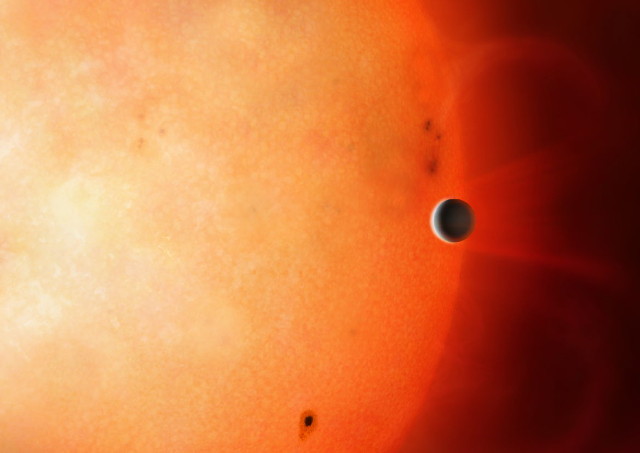
An article published in the journal “Nature” reports a study on the exoplanet TOI-849b, which appears to be the core of a gas giant stripped of its atmosphere. A team of researchers led by Dr. David Armstrong of the British University of Warwick used data collected by NASA’s TESS space telescope and ESO’s HARPS spectrograph to estimate the characteristics of TOI-849b. The result was that its mass is approximately 40 times the Earth’s with a size similar to Neptune’s, which means that its density is similar to the Earth’s. Its proximity to its star is probably the reason why it doesn’t have an atmosphere, although the possibility remains that it’s a sort of failed gas giant that couldn’t capture gas after the formation of the observed core.
About 730 light-years from Earth, the star TOI-849 is slightly smaller and less massive than the Sun, but is probably much older with an estimated age with a probability peak at about 6.7 billion years. This means that for what is, at least for the moment, the only planet orbiting it, there was a very long time to evolve, which means forming far from its star, migrating to the current position where its year lasts only 18 hours, and for this reason lose its atmosphere due to the stellar wind’s intense action.
Many cases of hot Jupiter planets, as they called exoplanets very close to their star and therefore very hot, are probably all losing their atmosphere and in some cases, this was detected. However, so far, no planet that could have been the primordial core of a gas planet that lost its atmosphere was discovered. TOI-849 b could finally be the first discovery of this kind.
To estimate the characteristics of this exoplanet, the researchers combined the observations of two very different instruments: NASA’s TESS space telescope, launched on April 18, 2018, which observes the transits of exoplanets in front of their stars, and the HARPS (High Accuracy Radial velocity Planet Searcher) spectrograph installed at the La Silla Observatory, in Chile.
The collected data allowed to estimate that TOI-849 b has a size similar to Neptune’s and a density similar to the Earth’s. This is a truly rare combination that could indicate that TOI-849 b is a so-called chthonic planet, which means a gas giant planet that lost its atmosphere of hydrogen and helium. The alternative hypothesis is that it’s a primordial core that for some reason interrupted its growth failing to capture the gas necessary to complete the formation of a gas giant.
Another oddity of the exoplanet TOI-849b is that it’s positioned in what’s called the Neptunian desert. That’s an area close to a star in which planets with a mass similar to Neptune’s are rarely found. One possibility is that the stellar wind evaporates the atmosphere of the Neptunians that approach their star while more massive gas planets have enough gravity to maintain their atmosphere for much longer.
The exoplanet TOI-849b might have lost its atmosphere due to the stellar wind, a phenomenon called in jargon photoevaporation. However, other processes might have intervened such as tidal destruction if at some point it came even closer to its star or even a collision with another planet.
Another hypothesis is that the exoplanet TOI-849b is a sort of failed gas giant. In this case, it would mean that for some reason the core has never been able to attract gas. This could have happened if there was a gap in the area of the protoplanetary disk in which it formed.
Dr. David Armstrong explained that we don’t yet have any information on the chemical composition of TOI-849b but it can be studied with other telescopes. If there’s a residual atmosphere, it must be resupplied by the core, so any trace would provide very useful information on its composition.
All these questions about the exoplanet TOI-849b will stimulate further research. The answers could provide important information on the processes of formation and evolution of planets. In particular, they could provide information on the conditions necessary for the formation of gas planets and on the possibilities that the ones that get close to their star lose most of their atmosphere, leaving in some cases a super-Earth.


Permalink
Great as always !
Permalink
Thank you for your appreciation! 🙂
Permalink
I propose that this core is dark matter which also exists at Earth’s core. I predict that it’s 3D orbit will show that it “hesitates” when crossing the solar plane.
This is analogous to SO-2 which will be shown to “hesitate” when crossing the galactic plane.
Permalink
Sorry but nothing supports your proposal. One of the great problems in dark matter research is that we can’t see it, while TOI-849b was discovered because it appeared in front of its star.
Permalink
I appreciate the planet core doesn’t shine like SO-2 and so any possible hesitation whilst crossing the plane of it’s host star will need advanced technology to observe.
The stall in physics for 50 years is direct support for thinking outside-the-box and therefore indirectly supports the hypothesis of Earth’s core being dark matter. A proposed additional strong gravitational interaction when on the same plane would be analogous to the extra strong Spring tides occurring when the Moon is on the equatorial plane. It’s a viable alternative to the view Newton and his peers had about the reality of matter & gravity.
Permalink
If you think you have actual evidence you should write an article and submit it to a peer-reviewed journal, otherwise sorry, but it’s wild speculations.